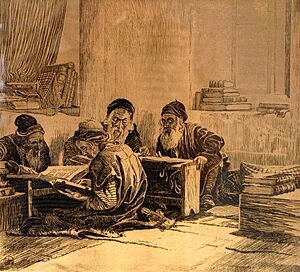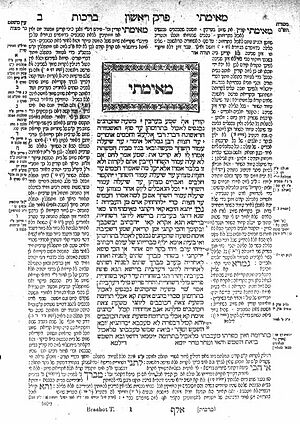Rabbinic Judaism facts for kids
Rabbinic Judaism is the main form of Judaism that most Jewish people follow today. It has been around since the 6th century CE. This type of Judaism believes that Moses received two parts of the Torah from God at Mount Sinai: the Written Torah and the Oral Torah. The Written Torah is what you can read in the Bible, and the Oral Torah helps explain it. At first, the Oral Torah was passed down by speaking, but later it was written down to make sure it wasn't forgotten.
Rabbinic Judaism is different from other Jewish groups like the Karaites because those groups don't believe in the Oral Torah. Even though there are different types of Rabbinic Judaism today, they all follow the ideas of the Oral Law and the ways rabbis interpret Jewish teachings.
Contents
Written and Oral Law in Judaism
Rabbinic tradition teaches that the details and explanations of the Torah (the Written Law) were first passed down by word of mouth. This is called the Oral Torah. It was given to Moses by God on Mount Sinai. The Written Torah only tells us that God gave these laws to Moses to share with the Jewish people.
Over time, Jewish people faced many challenges. To make sure these important oral laws were not lost, a wise leader named Rabbi Judah ha-Nasi wrote them down around 200 CE. This collection became known as the Mishnah. Later, more discussions and explanations about the Mishnah were added. These were called the Gemara. Together, the Mishnah and Gemara make up the Talmud. There are two main versions of the Talmud: the Jerusalem Talmud and the Babylonian Talmud.
Why the Temple's Destruction Changed Judaism
A very important event in Jewish history was the destruction of the Second Temple in Jerusalem by the Romans in 70 CE. This was a huge change for Jewish people. Before this, the Temple was the center of Jewish worship and learning. After it was destroyed, Jewish worship changed. Instead of sacrifices at the Temple, prayer became the main way to connect with God. Rabbis became the new leaders, teaching and guiding communities.
The destruction of the Temple made Jewish people ask big questions:
- How could they make up for their sins without the Temple?
- How could they understand why such a terrible thing happened?
- How could they live in a world ruled by Romans without their Temple?
- How could they keep their traditions alive?
Many Jewish groups existed before the Temple was destroyed, like the Pharisees, Sadducees, and Zealots. After the Temple fell, groups like the Sadducees, who were closely linked to the Temple, disappeared. The Zealots, who fought against the Romans, were also defeated. Only the Pharisees remained strong.
The Pharisees believed that Jewish law could be followed by everyone in their daily lives. This idea helped them answer the big questions and guide the Jewish people after the Temple was gone.
A wise Pharisee leader named Yohanan ben Zakkai helped Jewish life continue. He set up a new center for Jewish learning and law in a place called Yavneh. This new center, called the Sanhedrin, helped unite Jewish people. Instead of giving gifts to priests at the Temple, rabbis taught Jews to give to charity and study in local synagogues.
Later, around 132 CE, the Roman Emperor Hadrian planned to rebuild Jerusalem as a pagan city. This led to another big revolt by the Jews, led by Simon bar Kokhba. Some rabbis, like Rabbi Akiva, even thought Bar Kokhba might be the Messiah. This revolt ended in 135 CE when the Romans defeated Bar Kokhba. After this, most Jews were sent into exile, and they were not allowed into Jerusalem for a long time.
Around 200 CE, Rabbi Judah haNasi collected and organized many Jewish laws and traditions into the Mishnah. This was a key moment. It marked the change from Pharisaic Judaism to what we now call Rabbinic Judaism. The rabbis aimed to lead all Jewish people, and they changed prayers to reflect this unity.
Rabbinic Judaism built on old Jewish traditions but also changed to fit the new world without a Temple. Prayer services in synagogues became central, much like how Jews had practiced during their earlier exile in Babylonia. Because of these big changes, rabbis started writing down their discussions and laws. This was important because the old way of just speaking the laws could not be kept up.
Rabbinic Jewish writings are based on the idea that the Written Law cannot be fully understood without the Oral Law (the Mishnah). Much of this literature explains how to follow Jewish law. This body of interpretations is called halakha, which means "the way."
The Talmud includes many discussions about the Oral Laws believed to have been given to Moses. These laws often help prevent people from accidentally breaking the Written Torah's rules. For example, the Written Torah says not to travel far on the Sabbath. So, the Oral Torah says not to walk very long distances on the Sabbath, to make sure you don't accidentally break the rule.
Important Rabbinic Writings
As rabbis faced the new reality of Judaism without a Temple and without their own government, they began to write down their discussions. This was a big change from the old system where everything was taught by speaking. The idea that the destruction of the Temple led to writing down the Oral Torah was explained by a famous rabbi named Sherira Gaon.
The Oral Torah was written down in the Mishnah and Gemara. These texts are explained in other rabbinic literature that includes later decisions and writings by rabbis. Rabbinic Jewish writings believe that the Torah cannot be truly understood without the Oral Torah. They say that many rules in the Written Torah would be hard or impossible to follow without the Oral Torah to explain them. For example, the Torah says not to do "creative work" on the Sabbath, but it doesn't say what "creative work" means. The Oral Torah explains this.
Much of Rabbinic Jewish literature focuses on what actions are allowed by Jewish law. This collection of interpretations is called halakha, meaning "the way."
The Talmud: A Book of Jewish Wisdom
Jewish learning was first passed down by speaking. Rabbis would discuss and explain the law from the Hebrew Bible without written books, though some might have made private notes. This changed a lot after the Jewish people lost their government in 70 CE. Since rabbis had to lead Judaism without a Temple, they started writing down their discussions.
The earliest written Oral Law might have been like commentaries on the Torah. But around 200 CE, Rabbi Judah haNasi organized these teachings by subject into the Mishnah.
The Oral Law was not always the same everywhere. There were different schools of thought, like the School of Shammai and the School of Hillel. The Talmud usually records all valid opinions, even those that were not followed by everyone.
The Talmud has two main parts:
- The Mishnah (finished around 200 CE): This is the first written collection of Judaism's Oral Law.
- The Gemara (finished around 500 CE): This part contains discussions and explanations of the Mishnah and other early rabbinic writings. It often explores many other topics related to the Bible.
Rabbis who contributed to the Mishnah are called Tannaim. Rabbis who contributed to the Gemara are called Amoraim.
The Mishnah: First Written Oral Law
The Mishnah doesn't claim to be new laws. It's a collection of existing oral laws, traditions, and wisdom. The rabbis who helped create the Mishnah are known as the Tannaim. About 120 of them are known. The Mishnah was put together over about 130 years, spanning five generations of rabbis.
Most of the Mishnah's statements are not credited to a specific rabbi. This usually means that many wise people taught it, or that Judah haNasi and his court decided it. The legal decisions usually follow these uncredited views.
Rabbi Judah haNasi is known for publishing the Mishnah. He did this because the Oral Torah was in danger of being forgotten after the Temple's destruction and the Bar Kokhba revolt. He and his court also decided which opinions should be followed.
The Gemara: Explaining the Mishnah
The Gemara is the part of the Talmud that has rabbinical discussions and explanations of the Mishnah. For about 300 years after the Mishnah was written, rabbis in different places studied and debated it. These discussions became the Gemara. The word Gemara means "completion" or "learning." The Gemara mainly focuses on explaining and expanding on the ideas in the Mishnah.
Much of the Gemara is about legal analysis. It often starts with a legal statement from the Mishnah. Then, rabbis discuss and compare it with other statements, using different ways to interpret the Bible. They also try to find the biblical source for a law in the Mishnah and explain the logic behind it.
Jewish History
For more details on the story of the Jewish people, see Jewish history.
Orthodox Jewish Beliefs
Orthodox Judaism has a different view of Rabbinic Judaism's beginnings. They believe that Judaism has continued without a break from the time Moses received the Law at Sinai. They see Moses as the first rabbi, and they believe that knowledge and laws have been passed down from teachers to students through all of Jewish history, from the time of the biblical judges and prophets to today's rabbis.
See also
- Beth din



